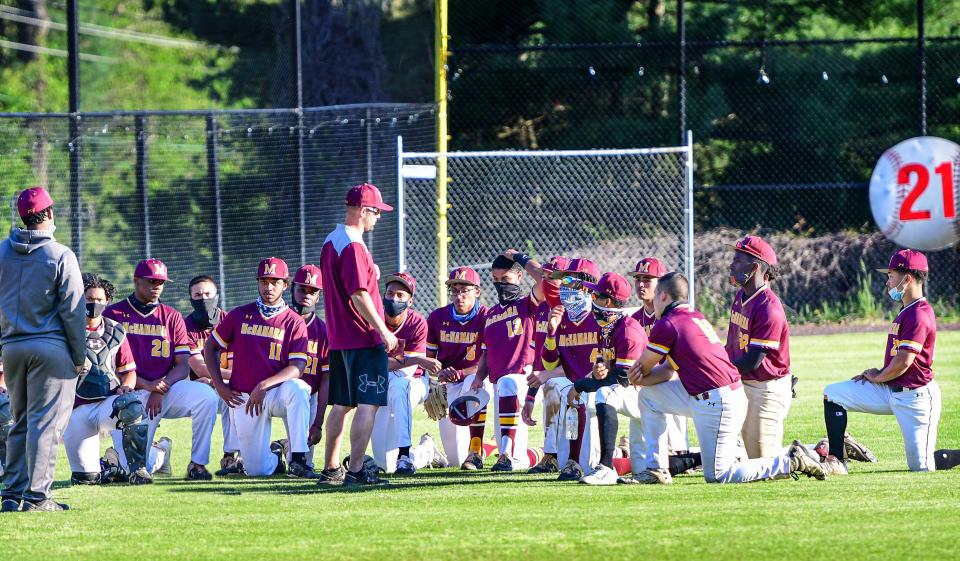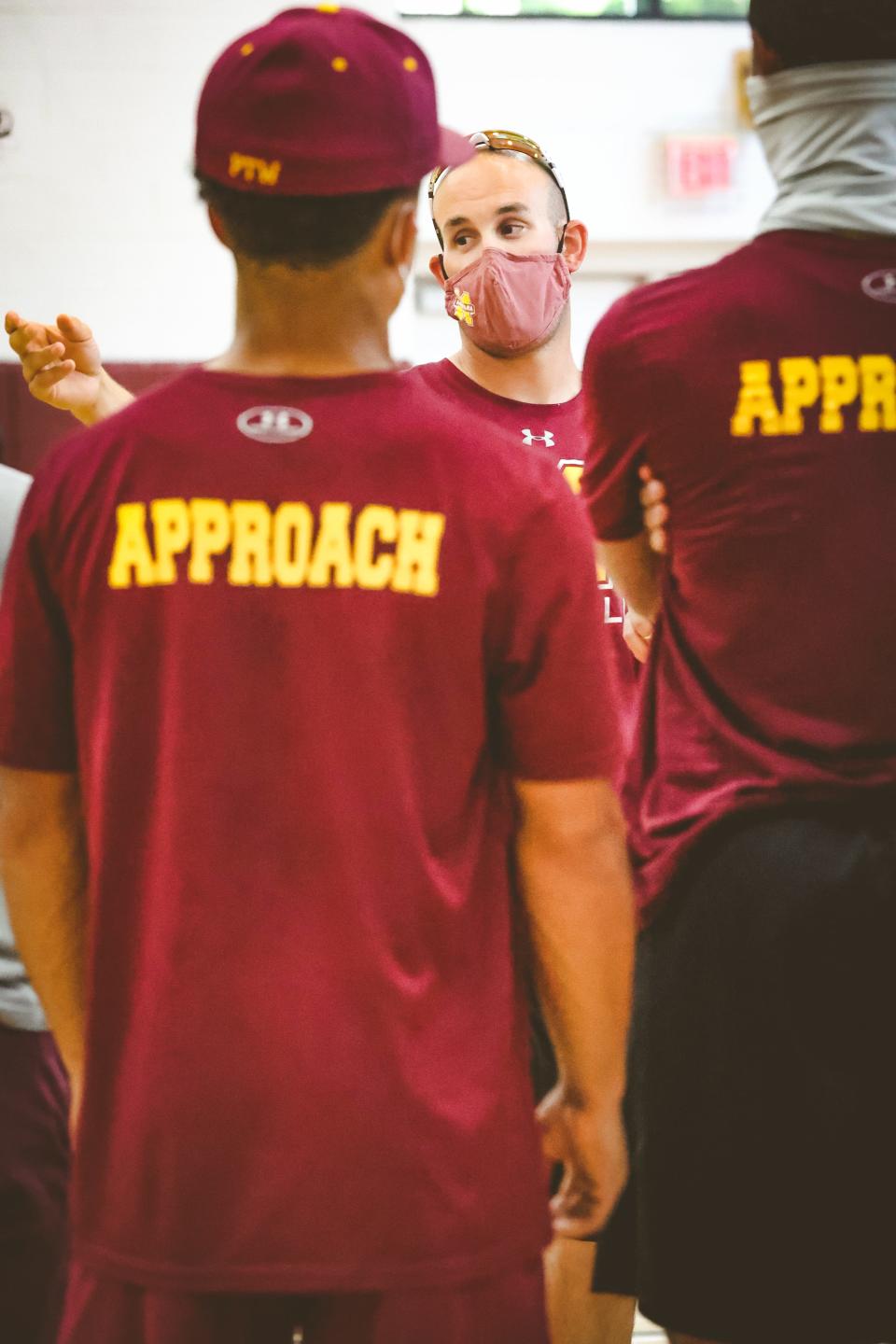Bishop McNamara high school shows baseball can beat its diversity problem
FORESTVILLE, Md. — When Anthony Sosnoskie confronted his quest to reshape the Bishop McNamara High School baseball program, some people told him he had to start recruiting the right kids.
“But what did they mean?” Sosnoskie told USA TODAY Sports while his team warmed up inside the school’s gymnasium. “They meant a white kid.”
The student body of Bishop McNamara, a Catholic grades 9-12 coed school, is around 90% Black among the 850 students. That percentage is even higher on Sosnoskie’s 2021 roster. None of his 20 players are white – 18 are Black or mixed, and two are of Asian descent – in a sport that remains predominately Caucasian at all levels and in an area where other youth sports are the more popular choices.
Bishop McNamara is a hopeful sign that the lack of diversity in all levels of baseball can one day improve.

Compared to sports such as the NFL, where Black players make up approximately 70% of the league, and the NBA, where the percentage is even higher, the number of Black players in MLB this season is 7.1%, or 64 players, on opening-day rosters and injured lists, according to analysis by USA TODAY Sports.
The NFL and NBA have legions of Black players who dream of playing their sports, but Black peo, and other people of color, based on the numbers, see baseball as an afterthought. Bishop McNamara shows there might be significant pockets in the country where that isn't the case.
“You don’t walk out there (with your friends) like, ‘Let’s play baseball.’ It’s always like, ‘Nah, basketball, football.’ So it’s something different,” senior Miles Peterson said. “Once you’re good at baseball, you can be good at any other sport. Baseball players are athletes. You can do anything. (Anyone) can shoot a (3-pointer), but you can’t hit a baseball.”
Some of Bishop McNamara’s opponents in the Washington Catholic Athletic Conference (WCAC) may have one or two Black players, Sosnoskie said, but the majority of teams are all-white.

“I think it’s something that actually drives us, since we’re minority-based,” said senior Ryan Davis, who will play at Maryland-Eastern Shores. “Just make a name, earn respect for ourselves. Our skin color can play the game.”
One team, Davis said, hasn’t been shy about making monkey noises when McNamara takes the field. There was an incident in 2019 when someone shouted the N-word from a car whizzing by a practice.
“We just use it as motivation,” Davis said.
This senior class, six of whom will play in college from the junior level to Division, is the winningest in school history. For years, Bishop McNamara was a bottom-feeder on the diamond. Then Sosnoskie, a special education teacher at the school who is white, arrived in 2014. The struggles continued; he won six games in each of his first three seasons.
But two years ago, the Mustangs went 22-7, setting the record for school wins. In the playoffs, they lost the last two games of a three-game series to rival DeMatha Catholic and played one game in 2020 before the pandemic canceled the entire season. This year, they are 5-3 – including a pair of revenge wins over DeMatha – with three games remaining. The WCAC will not have playoffs and their season will conclude on June 3.
More than 20 players have gone on to play college baseball since Sosnoskie – a former Division I player at Virginia Tech with a short stint in independent ball -- became coach, meaning he’s talked his team up to coaches at the next level. Those conversations often involve the “raw” label many Black baseball players bear.
“We have good, talented players, who sometimes don’t believe they know as much about the game as they actually do," Sosnoskie said. “That gets them labeled ‘raw talents’ by people. That’s something we’ve tried to break down: ‘He’s a good baseball player. He happens to be super athletic, OK, whatever. He’s a good baseball player. He’s slow, actually, he’s not going to steal second base.’”
That is a real stereotype that plays out during Mustangs games. Players will reach base and teams will throw over four or five times even if the player isn’t a base-stealer.
Sosnoskie said he recruits a 45-minute radius around campus. Players primarily hail from Prince George’s County, where the school is located. Some players’ families are financially well-off, and others aren’t.
It’s no secret the financial costs of youth baseball – and the growing popularity of the travel aspect – have increased, making the game less accessible to low-income families and leading to less racial representation in the major leagues. The Society of Baseball Research says the percentage of Black players in MLB has declined since 1981 and reached its lowest point, 6.7%, in 2016 – the lowest since 1957.

“I feel like this game is suited for people of all sizes, all wealth statuses and income,” Mustangs assistant coach Raphael Lockett, who is Black, said.
Lockett, an engineer for the Navy by day, played collegiately at Jackson State and has been Sosnoskie’s assistant for three years. Sosnoskie recruits from the Washington Nationals Youth Academy, where Lockett was the lead baseball instructor. His life passion is working with kids, “trying to get more people of color back in the game.”
The Black community often sets trends before the rest of society follows, Lockett said. That can be a hurdle to convince Black players to stick with baseball.
“Nobody likes to be seen failing. And in this game, you fail a lot. So (the coaches’) goal is pumping them up, letting them realize, ‘Hey, you’re going to be your best self,’” Lockett said. “This game is about discipline and probability. So if you do things the right way, you’ll get success.”
That’s balanced with giving the players a feedback loop to ensure they are having fun. Music blares during warmups and stretching. Lots of screaming happens as players rope batting practice inside a mesh net constructed in the gymnasium.
But when Sosnoskie addresses the team? Not a pin-drop.
The Mustangs’ practice shirts have different words on the back: Approach. Contribute. Sacrifice. Locked In. Every hat, though, has “PTW” on the back.
Play To Win.
“Having that dynamic, with a group of African Americans who realize, ‘Hey you know what? We can struggle. But we can succeed together. It takes a community. It takes a village,’” Lockett said. “So all the things we want in society, happens in the game of baseball.”
Follow Chris Bumbaca on Twitter @BOOMbaca.
This article originally appeared on USA TODAY: Bishop McNamara shows baseball can beat its diversity problem

